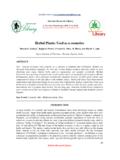Transcription of Ancient Sunrise® Henna for Hair, Chapter 5, Plants …
1 Ancient Sunrise Henna for Hair, Chapter 5, Plants that Dye Hair Copyright 2015 Catherine Cartwright-Jones Cover Graphic by Alex Morgan Published by TapDancing Lizard LLC. 339 Tallmadge Rd. Kent, Ohio, 44240. Terms of Service: Creative Commons: Attribution-NonCommercial-NoDerivs Unported You are free to Share, to copy and redistribute this material in any medium or format under the following terms. The licensor cannot revoke these freedoms as long as you follow the license terms. Attribution - You must give appropriate credit and provide a link to the license. You may do so in any reasonable manner, but not in any way that suggests the licensor endorses you or your use. Non-Commercial - You may not use this material for commercial purposes. No-Derivatives - If you remix, transform, or build upon the material, you may not distribute the modified material in any form or by any means.
2 For further information on Henna and hair, please visit To purchase Henna , please visit HELP DESK AND ORDER DESK: call 330-673-0600 or toll-free 855-MEHANDI. Ancient Sunrise Henna for Hair, Chapter 5, Plants that Dye Hair, Copyright 2015, Catherine Cartwright-Jones PhD, TapDancing Lizard LLC Three Plants Dye Hair: Henna , Indigo, and Cassia Powdered cassia, Henna , and indigo leaves Few Plants can be used to dye hair conveniently and safely. Henna , indigo and cassia powders are green powders, similar in appearance, because they are all dried powdered leaves, and all contain dye molecules that can safely and effectively dye hair. The green chlorophyll in the leaves hides the dye molecules. Cassia contains a yellow dye molecule. Henna contains a red- orange dye molecule. A dark blue dye molecule can be derived from indigo.
3 These dye molecules will stain keratin, the structural protein of hair. Cassia, Henna , and indigo stains on light-colored human hair The shape of a hair keratin molecule has sites for dye molecule binding, and these sites have specific shapes and conditions for binding. Henna has lawsone, a napthoquinone molecule, which binds very efficiently with keratin. Cassia has chrysophanic acid, an anthraquinone, which does not bind as efficiently as Henna . Fermented indigo has a molecule, indigene, which can be broken down to an indoxyl that will bind to keratin, but this molecule is unstable. One way or another, the pigment in the powdered cassia, Henna , or indigo leaves has to migrate from the leaf to the hair, and then bind with the keratin in hair, rather like tetriminos' that you coax into place during a game of Tetris, or like a wet tea bag staining a white tablecloth.
4 Only a few pigments will bind with hair and dye it permanently. Beet juice won't dye hair red; it will wash out. Blueberries won't dye hair blue. Beet juice and blueberries will color ice cream, but their dye molecules aren't the right shape for keratin tetris.' Madder can temporarily stain hair rich red, but fades after a few washings. Wool and silk dyers often use heat and mordants to make differently shaped molecules attach to hair. Heat expands the keratin molecules, so it's Ancient Sunrise Henna for Hair, Chapter 5, Plants that Dye Hair, Copyright 2015, Catherine Cartwright-Jones PhD, TapDancing Lizard LLC easier to jam in a molecule that doesn't quite fit. Mordants rough up' a molecule so it's easier to jam in a dye molecule that doesn't really When these cassia, Henna , and indigo molecules bind with keratin, they dye Different fruit juices mixed with cassia will change the stain results.
5 Cassia is translucent and the results will be different on different colors of hair. Cassia will not make hair a paler color. Different fruit juices mixed with Henna can change the stain results. Henna is translucent and the results will be different on different colors of hair. You can achieve a broad range of colors by mixing cassia, Henna , and indigo, and using different fruit juices in the mix. You can dye hair black cat black' by dyeing it first with Henna , then dyeing over that with indigo. 1. Since it is imprudent to boil your head or soak it in a caustic solution, we're limited to the few molecules that bind easily to keratin. 2. Painting hair is different from dyeing hair. Paint adheres to a surface (like a tee shirt with a rock band logo). A. dye penetrates the surface and stains it (like a tie dye tee shirt).
6 Ancient Sunrise Henna for Hair, Chapter 5, Plants that Dye Hair, Copyright 2015, Catherine Cartwright-Jones PhD, TapDancing Lizard LLC Henna , Lawsonia Inermis Henna , lawsonia inermis: new leaves after a summer rain. What is Henna ? Henna , lawsonia inermis, is a large bush or small tree native to hot, dry climates across North and East Africa, the Arabian Peninsula, the southern areas of the Middle East, and South Asia. Henna probably originated in North Africa, based on the greater genetic diversity in Henna in the North African oases than in other Humans probably first developed their use of Henna during one of the moist' phases in the region of the Sahara; the most recent greening' was from nine thousand to about five thousand years ago. There is archaeological evidence from Egypt that Henna was regularly used to treat skin ailments and to color gray hair five thousand years ago.
7 There is evidence that brides marked their hands and feet with Henna for weddings in Mesopotamia and the eastern Mediterranean. Henna will tolerate long droughts and high heat, but not moist soil or frost. Henna does not grow in any area where there is frost. Henna does not grow in rainforest climates. Muslim traders and settlers brought Henna to western Australia, and it has naturalized there. Henna has never grown in the Americas other than as an imported decorative plant, though there are a few permanently warm and frost-free areas where it could be naturalized in Mexico and Argentina. 3. Boubaya, Anissa, H dia Hannachi, Nidhal Marzougui, Tebra Triki, Ferdaws Guasmi, and Ali Ferchichi. 2013. "Genetic diversity assessment of Lawsonia inermis germplasm in Tunisian coastal oases by ISSR and RAPD.
8 Markers." Dendrobiology 69, 31-39. Ancient Sunrise Henna for Hair, Chapter 5, Plants that Dye Hair, Copyright 2015, Catherine Cartwright-Jones PhD, TapDancing Lizard LLC In the 19th and early 20th centuries, most of the Henna used by Europe and the USA was grown in Egypt. India is presently the largest exporter of Henna . Indian governmental support of the Henna industry has improved Henna cultivation and technology, helping farmers to have a cash crop during years when other crops fail. The Indian government also supplies free Henna Plants to farmers in the arid western region to protect their soils from desert encroachment. Henna , lawsonia inermis Henna 's leaves have a red-orange dye molecule, lawsone, visible in young leaves in the center vein of the leaf. The petiole, the center vein of the leaf, has the highest lawsone content.
9 4 Henna branches grow quickly after rainy spells. The small branches are then pruned back and the leaves stripped away and allowed to dry. On commercial Henna plantations, little trees are often pruned of their branches back to 3' tall; the branches will regrow quickly after the next rain. Henna may be pruned for leaf harvesting up to three times a year, and may live for fifty years. In western India where there are large fields of Henna , the November harvest generally has the highest lawsone content, following the rapid growth from the monsoon rains. 4. The petiole is the center rib of a leaf. In Romaine lettuce, the petiole is the crunchy center part. Ancient Sunrise Henna for Hair, Chapter 5, Plants that Dye Hair, Copyright 2015, Catherine Cartwright-Jones PhD, TapDancing Lizard LLC Henna , lawsonia inermis The fully-grown leaves contain to 4% lawsone content, depending on climate, weather, and soil conditions.
10 Commercially available pure Henna sold for body art typically has to lawsone after milling, packaging and export. The lower dye content leaves, to lawsone, roughly powdered and sifted, are sold to the hair dye It is not true that the greenest leaves have the highest dye content, though brown leaves may be poor quality. Indian Henna exporters often put green dye in their Henna to make it appear to be better Ancient Sunrise Henna does not contain green dye. Henna leaves may be used fresh, though they are more often harvested, dried, and powdered. When pulverized Henna leaves, fresh or dried, are mixed with a mildly acidic fruit juice, the lawsone molecules in the Henna will be made available for dyeing. If you put Henna paste on skin or hair, the lawsone molecules will migrate from the plant pulp, into keratin, leaving a red- orange stain.








